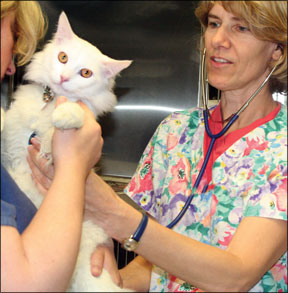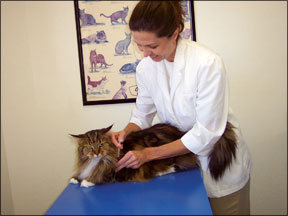Your seven-year-old cat is a generally healthy animal. Except for a fleeting bout of gastrointestinal upset a few years ago, shes never had a really serious sick-day in her life. But your neighbors cat always seems to be ill. Indeed, every three or four months she shows up on your doorstep wheezing, sneezing and coughing. Her 288 eyes are red and watery, and she acts lethargic. These disturbing signs persist for a week or 10 days, but then she seems to be all right again – for a while. Its quite likely that the cat next door is suffering from a deeply rooted upper respiratory infection, a highly contagious disease affecting her nose, sinuses, pharynx and larynx – the structures that filter, heat and dehumidify inhaled air before it flows to her lungs. Why is it, you wonder, that your cat never experiences this problem, while the cat next door cant seem to shake it? The answer, most probably, is that you conscientiously take your cat to your veterinarian for periodic booster vaccination to protect her against the infectious agents responsible for most feline upper respiratory infections. Your neighbors cat, on the other hand, hasnt seen a veterinarian in years. Potential Problems
Although the primary clinical signs of upper respiratory infection are troublesome and often debilitating, they are generally transitory and self-limiting – they just come and go without causing enduring harm. However, they can progress to secondary complications with long-lasting and potentially severe consequences.
These include pneumonia, conjunctivitis or corneal ulcers (vision-impairing eye conditions), and a host of other virus- and bacteria-borne illnesses resulting from the entry of infectious microorganisms into an afflicted cats system via the open sores that often break out inside its mouth and on its nose, lips and tongue. In addition, some cats may refuse to eat because of the painful ulcerations in their mouths and may consequently become systemically ill as the result of a nutritional deficiency.
Major Offenders
“About four out of five upper respiratory infections are caused by one of two viruses,” says Fred Scott, DVM, PhD, professor emeritus of virology at Cornell Universitys College of Veterinary Medicine and the founding director of Cornells Feline Health Center. An estimated 40 percent of cases are caused by feline herpesvirus (FHV), which is also known as feline rhinotracheitis virus (FRV), and about 40 percent are caused by feline calicivirus (FCV). “The remainder, notes Dr. Scott, “are caused by a bacterial agent called
Chlamydophilia felis and other microorganisms.”To complicate matters, infection with feline immunodeficiency virus (FIV) and feline leukemia virus (FeLV), although not directly associated with upper respiratory disease, may compromise an animals immune system and thus make it more susceptible to respiratory infection.
These viruses are usually passed from cat to cat when they lick or groom one another, notes Dr. Scott, or through other direct physical contact. These viruses can also be airborne. “During the acute stage of infection,” he says, “theres a lot of sneezing going on. An infected cat will blow the virus out into the environment, and cats a few feet away will inhale it. A virus can also be transmitted from an infected queen to her kittens during pregnancy or through grooming them after they are born.”
Disease Progression
Once present in a cats system, no medication can make the viruses simply disappear. Herpesvirus will remain in an infected cats system forever, resurfacing periodically to cause recurring episodes of fever, ocular inflammation, nasal discharge, sneezing and other signs of rhinotracheitis. As for calicivirus, it will typically vanish from an affected animals system within a year or so after the initial infection, but in some cases not until after it has done significant damage to the cats upper respiratory system and has opened the pathways for secondary infection.
Herpesvirus, explains Dr. Scott, initially announces its presence by causing acute sneezing attacks in its host. But its impact is felt beyond the respiratory system components. “The virus starts to replicate and destroy cells in the animals nose,” he explains. “This will typically be followed by a discharge of fluid from the cats eyes. It may be noticeable initially in just one eye, but both eyes will soon be involved. And the discharge will be watery at first, but it may become progressively purulent. This is often followed by conjunctivitis – inflammation of the mucous membrane that lines the inner surface of the eyelid. And in a small percentage of cats, you may see signs of corneal ulceration.” The length of time it takes for the disease to run its course and for the clinical signs to subside ranges, he notes, “anywhere from a day to a week or so.”

288
Once present in the feline system, however, herpesvirus remains forever and clinical signs continue to flare up repeatedly, with recurrences brought on by such things as stress, bad weather, the outbreak of some other illness or medications that suppress the immune system.”
“Its a very common infection in mature cats that have not been vaccinated against it,” says Dr. Scott, “and almost all of these affected animals will recover. But it can kill very young kittens or those that have been infected in the uterus, because the infection can easily develop into a serious systemic disease.”
The signs and progression of a calicivirus infection are “entirely different,” Dr. Scott points out. “There is less sneezing and not as much eye involvement. But you may see ulcers on the affected cats tongue, lips and sometimes around its claws. And some strains of this virus can cause fatal pneumonia.”
The signs progress for about a week, he says, noting that “the calicivirus disease comes on a little faster than the illness caused by herpesvirus infection, and the disease course is a little shorter. Most cats will survive the initial infection, but the real danger is pneumonia, which can come on very fast and be fatal.”
As with herpesvirus, he says, kittens are significantly more susceptible to serious systemic disease – especially pneumonia – resulting from a calicivirus infection. “Kittens are protected for a few weeks by the natural immunity theyve gotten from their mothers,” says Dr. Scott, “but they become susceptible after that immunity wears off.”
Effective Vaccines
For the past several decades, vaccines have been available that, to a great extent, protect cats against herpesvirus and calicivirus, and these vaccines have proven successful over the years in significantly reducing the occurrence of upper respiratory disease.
Dr. Scott urges all cat owners to make sure that their cats are vaccinated according to the schedules recommended by veterinarians. In general, a single vaccine designed to protect against both herpesvirus and calicivirus should be administered when a kitten is between six and eight weeks of age (when the natural immunity they have received through colostrum-rich mothers milk is diminishing). One or two follow-up shots are recommended at three-week intervals, then a single booster vaccination should be given one year after the final kitten vaccination, with revaccinations given every three years thereafter.
Unfortunately, no vaccine is 100-percent effective. Although all existing vaccines are apt to reduce the severity of viral infections, none can be guaranteed to immunize all cats against the organisms that cause upper respiratory disease. Also, new strains of feline calicivirus are continually evolving; therefore, the efficacy of current vaccines may diminish as time goes by.
v


